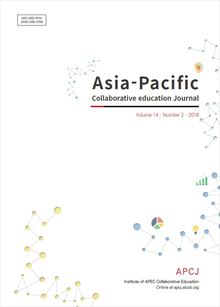간행물
Asia-Pacific Collaborative education Journal

- 발행기관 APEC국제교육협력원
- 자료유형 학술지
- 간기 반년간
- ISSN 2092-674X (Print)2092-6758 (Online)
- 수록기간 2004 ~ 2021
- 주제분류 사회과학 > 교육학 사회과학 분류의 다른 간행물
- 십진분류KDC 371DDC 379
권호리스트/논문검색
Volume 15 Number 2 (2019년 12월) 4건
1.
2019.12
구독 인증기관 무료, 개인회원 유료
The purpose of this study is to examine the concepts and features of K-fishbone analysis used in the AeLT program and to find suggestions. For this purpose, I analyzed the AeLT Training Manual and lecture PPT file and AeLT final reports. The procedure of K-fishbone analysis is as follows. First, specify the problem to be solved. Second, brainstorm the cause and factor of the problem. Third, cluster problems and elements with the same factors. Fifth, the branching branches (2nd branch , 3rd branch) extending from large thorns become the sub-cause. After all the causes of the problem have been identified, the causal relationship and the correlational relationship are analyzed. The cause of receiving the most arrows is the fundamental cause and the priority of the solution. K-fishbone analysis should 1) consider as many causes and sub-factors as possible through brainstorming and 2) by doing casual and correlation relationship analysis, help to ① determine the more critical factors of the problem, ② remove unnecessary elements that hinder the discussion, so increase concentration on the subject, and ③ in the situation of the lack of data and information, improve the analyst's understanding of the problem and its causes. Moreover 3) It is suitable for solving problems especially in developing countries. The implications of K-fishbone analysis are as follows. First, it can be effectively used in invitational training for policy makers in developing countries. Second, it will be more widely used in inquiry classes in the school. Third, it can be widely extended and utilized as a method of RCA.
4,000원
2.
2019.12
구독 인증기관 무료, 개인회원 유료
This study examined the influence of ICT on vocational and technical skills acquisition among polytechnic students in Osun State. The sample of the study was 350; consisting of undergraduate students from 2 Polytechnics in Osun State. Self-developed questionnaires were made and validated through pilot testing and administered to the sample for the collection of data. The researcher personally visited respondents, thus 100% of data were collected. The collected data were tabulated and analyzed by using percentage, frequency count and t-test analysis. The major findings of the study were that there is a significant difference in the impact of ICT on vocational and technical skills acquired by students of Polytechnics in Osun State, ICT has a greater impact on vocational and technical skills acquired by male students than that of females. It was also concluded that there is a significant difference in the impact of ICT on vocational and technical skills acquired by students of Polytechnics in Osun State based on specialization. Based on the findings of the study, major recommendations were enumerated as the government should develop ICT software that will be applicable to their indigenous cultures so as to make ICT more relevant to the local needs of the people, educators should be sponsored to attend workshops, seminars, and conferences, both locally and internationally, and educational programmes should be restructured to make them utility oriented, among others.
4,000원
3.
2019.12
구독 인증기관 무료, 개인회원 유료
The purpose of this article is to understand the features of collaborative education in terms of volunteer programs that were carried out in Filipino elementary and secondary schools. We adopted narrative case study with which we brought up past impressive experiences interacting with Filipino teachers and students in the context of sharing multimedia technology. Specifically, this paper highlighted what the volunteer members felt and appreciated from Filipino educational and cultural settings while trying to offer our multimedia facilities and expertise to them. We narratively presented more humane and artistic impressions that we took benefits from Filipino schools, even though volunteer activities were planned to help Filipino teachers enhance their technical skills with subsidiary computer facilities donated as part of APEC collaborative education project. Ethnographical and narrative descriptions for the volunteer experiences illustrates humane and artistic features that were appreciated while interacting with Filipino teachers and students.
4,000원
4.
2019.12
구독 인증기관 무료, 개인회원 유료
The study aims to assess the use of social networking sites among Educational Technology (Edtech) students of Philippine Normal University Visayas. Descriptive method was used. A total of 95 respondents participated, 27 were males and 68 were females. The statistics used were: frequency, percentage weighted mean, and rank. The top three uses of social networking in the personal life of the respondents according to rank are: 1) to connect with people, 2) to do research, and 3) to e-mail people. With regard to its use in their academic life, the top three are: 1) to do research, 2) to e-mail, and 3) to connect with people. The social networking sites which ranked number one as being used by the respondents are Google for research, Yahoo for e-mail, Facebook for connecting with people and OLX for purchasing. The study disclosed that the respondents “agree” with the benefits of social networking. It was concluded based on the findings of the study that there are social networking sites used to a high extent by the respondents. However, they are limited only to Facebook, Google and Yahoo. The foremost use of social networking is for researching, chatting and messaging and uploading and downloading. Furthermore, it was concluded that the respondents are aware that social networking has both benefits and risks. The researcher recommends the following: the students should be given trainings and workshops on the effective use of social networking; the teachers should monitor the social networking done by their students for purposes of proper guidance and information.
4,200원

